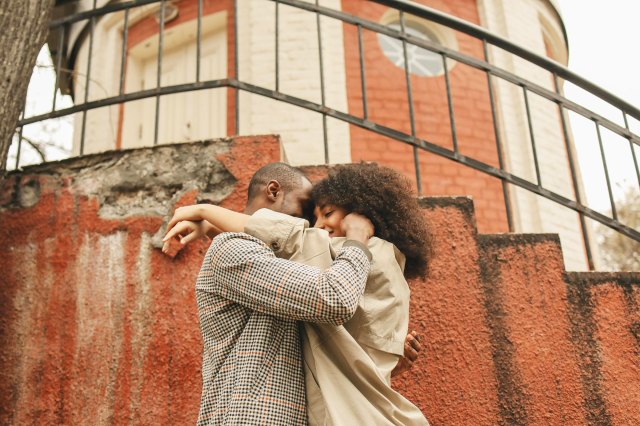
Chemical Surges
When we first feel attracted to someone, our brain’s primary reward center — known as the ventral tegumental area (or VTA) — begins to activate. It’s here that dopamine is made, one of the key ingredients in the brain chemistry cocktail of love.
This neurotransmitter is known for creating sensations of pleasure and reward, and as the dopamine bounces around our brain’s limbic system, we get a rush not unlike the feeling of other pleasurable activities, from eating your favorite food to achieving a goal to the electric sensation of a first kiss. It’s an intoxicating reaction that’s also been likened to the way bodies operate in addiction.
Alongside dopamine, another hormone called norepinephrine (or noradrenaline) kicks in. Norepinephrine is primarily known for its role in the body’s “fight or flight” response, but in matters of love, it enables that single-minded focus on the object of our desire — as well as those butterflies in our stomach.
According to Harvard University, brain scans have shown just how active our brains are when we feel this initial rush of attraction: The VTA and caudate nucleus (another of the brain’s main reward centers) light up like fireworks when people are shown photos of someone they feel drawn to. Interestingly, while dopamine and norepinephrine levels soar, serotonin levels tend to drop when first falling in love. Low serotonin is linked to obsessive thinking, which is believed to be responsible for those early days of infatuation.

Racing Hearts
The sensations of being in love aren’t limited to the brain, of course; as your mind kicks into subconscious overdrive, it triggers physical reactions that can feel contradictory to the warm fuzzy feelings swirling in your brain. The excitement caused by surges of dopamine and norepinephrine trigger your adrenal glands, which lead to — you guessed it — a flood of adrenaline.
This can cause racing hearts, flushed cheeks, dilated pupils, and, unfortunately, those nervous, sweaty palms, especially when we’re around the person responsible for putting us in this state in the first place. With all this extra adrenaline, it can be hard for someone in the early phases of love to eat or fall asleep, which can take an unexpected toll on our poor, lovesick selves.

Higher Pain Thresholds
If that first flush of love also has us feeling invincible, there’s a reason: A Stanford University study found that being in love can noticeably heighten our pain tolerance. Participants in the first stages of infatuation looked at various photos while a heated probe was pressed into their hand. Looking at a photo of their love reduced moderate pain by around 40% and severe pain by up to 15% when compared to looking at a photo of an acquaintance. It’s thought that viewing a photo of a romantic love activates our dopamine, which can help regulate pain in a process sometimes referred to as “love-induced analgesia.”
People in love also tend to have stronger immune systems. Research has shown that people in the early stages of a romantic relationship displayed changes in gene expression. Participants who were in the midst of that fierce, early love showed a noticeable boost in the activity of certain immune-related genes, hinting that their bodies might be better equipped to fight off illness. This is likely due to the increased production of dopamine and oxytocin, both of which are important for the functionality of our immune systems.
More Interesting Reads

Bonding Hormones
As relationships progress, the initial dopamine-fueled high fades, and oxytocin takes over. Sometimes known as the “love hormone” or “cuddle hormone,” oxytocin is made in the hypothalamus and makes its way to the bloodstream through the brain’s pituitary gland. It’s released during moments of physical closeness and serves to strengthen attachment; it lowers stress and helps facilitate feelings of calm and comfort around a loved one. It’s also released in high amounts during pivotal moments of connection, such as childbirth and breastfeeding.
Vasopressin is another hormone that helps foster deeper bonds when the dopamine dries up. In studies on prairie voles — animals that, like humans, have a tendency toward monogamy — scientists found that vasopressin levels were linked to the strength of the animals’ bonds. In humans, vasopressin is also thought to contribute to the feeling of wanting to protect and provide for one’s partner.

The Pain of Heartbreak
Just as falling in love can do a number on your mind and body, so can the end of a passionate romance. The pain of losing love can cause stress-induced cardiomyopathy, also known as takotsubo cardiomyopathy or “broken heart syndrome.” Part of the heart — usually the left ventricle — temporarily swells and weakens, preventing the heart from functioning properly. It can be triggered by intense emotional stress, and the symptoms, including chest pain and shortness of breath, often mimic a heart attack.
While love is, at its core, a feeling that most likely evolved to support reproduction, it has long evolved far beyond that to become the lynchpin of the deep social connections that make us human. Even when it feels abstract or confusing or out of control, love is fundamentally a biochemical process — a simple scientific fact that can help us feel grounded when in the throes of romance.












